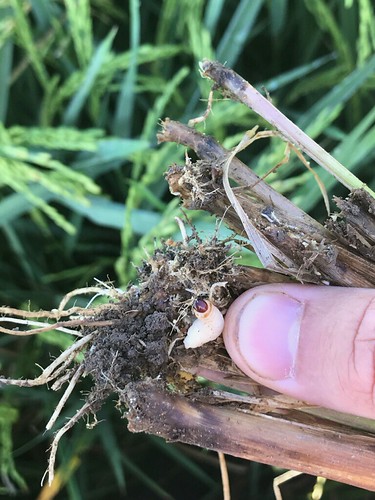Insect problems emerge as row rice acreage increases
By Sarah Cato
U of A System Division of Agriculture
Aug. 13, 2018
Fast facts:
- Billbugs, weevils that cannot survive in standing water, are feeding on row rice
- Entomologists are seeing increasing pressure in near Newport, Newark and Crockett’s bluff and in Desha county
- Research in progress in search of a solution
(520 words)
(Newsrooms: with art https://flic.kr/s/aHsmquFjSB)
(Download this story in MS Word format here.)
NEWPORT, Ark. – Billbugs, once an occasional pest of rice that cannot survive in standing water, are putting increased pressure on crops as row rice acreage rises.
Billbugs are weevils whose larvae bore into the side of rice tillers, or stems, which deprives developing grain heads of nutrients. This leads to “blank heads,” or heads that never developed kernels. Billbugs cannot survive aquatic conditions, making row rice, which does not hold a continuous flood, an ideal environment.
“We’ve been saying for the last few years as row rice becomes more popular, we’re going to have a billbug problem,” said Nick Bateman, extension rice entomologist for the University of Arkansas System Division of Agriculture. “And there have been some reports over the past couple of years, but this is one of the first years we’ve seen, at least in pockets, a substantial number of billbugs.”
Because billbug larvae bore into the side of rice tillers, most damage isn’t seen until it’s too late.
“The damage doesn’t stop the head from forming, but it kills the tiller, so in turn it’s killing that head as it’s trying to push out of the boot,” Bateman said. “Now that rice is mostly headed out, we’re starting to see a lot of blank heads.”
Billbugs tend to stay near the bottom of the plant, making scouting extremely difficult, but there are clues.
“They’re most likely not moving up and down the plant a lot, so we could maybe get down on our hands and knees and scout for them, but that’s just not feasible,” Bateman said. “Similar to rice water weevils, billbugs come out of a tree line. So it’s going to be the high end of the field in row rice or on levees and it’s going to be near a tree line.”
It is still unclear which form of control will be effective, but there are trials in place this year and more planned for the future. Because there is a period of time between when adults migrate to the field and when damage appears, Bateman is hoping to test timed foliar applications as well as seed treatments.
“We’re exploring seed treatment combinations and we’re hoping there’s some combination that will give us some control,” Bateman said, “We’re also trying to look at whether it’s based on the growth stage of the rice or maybe a calendar event, so that we could maybe time a foliar application.”
The race is on with billbugs in Arkansas. Although infestations aren’t widespread, row rice acreage is increasing and extension entomologists are working on a solution.
“We have to get information out there to people,” Bateman said. “With the popularity of row rice right now we have to get information to our growers quickly and that’s our plan moving forward. We’re going to double down on billbug research and try to find some way to deal with this pest, especially in a row rice setting.”
For more information on insect control in rice contact your county extension office or visit www.uaex.uada.edu.
About the Division of Agriculture
The University of Arkansas System Division of Agriculture’s mission is to strengthen agriculture, communities, and families by connecting trusted research to the adoption of best practices. Through the Agricultural Experiment Station and the Cooperative Extension Service, the Division of Agriculture conducts research and extension work within the nation’s historic land grant education system.
The Division of Agriculture is one of 20 entities within the University of Arkansas System. It has offices in all 75 counties in Arkansas and faculty on five system campuses.
Pursuant to 7 CFR § 15.3, the University of Arkansas System Division of Agriculture offers all its Extension and Research programs and services (including employment) without regard to race, color, sex, national origin, religion, age, disability, marital or veteran status, genetic information, sexual preference, pregnancy or any other legally protected status, and is an equal opportunity institution.
# # #
Media Contact: Mary Hightower
Dir. of Communication Services
U of A System Division of Agriculture
Cooperative Extension Service
(501) 671-2126
mhightower@uada.edu
